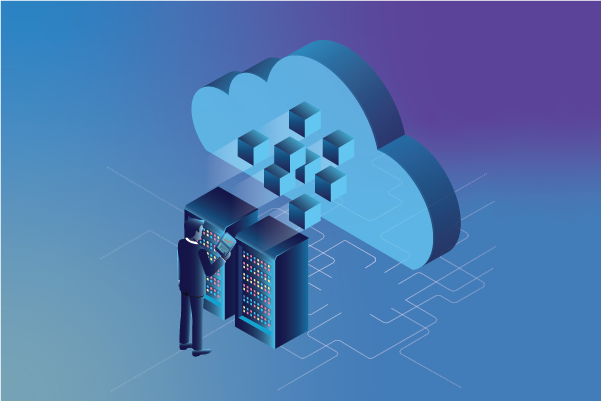Imagine building a sandcastle and then trying to add another tower, without affecting the rest of the structure.
The outcome? chaotic, disordered, and an extreme waste of your time and effort.
Now, let’s use the same example in the context of building an application for your enterprise. Thanks to technology, such modifications are possible, if you have the right technology at your disposal.
Downsizing and upsizing the application according to user needs is quick and easy with modern infrastructure. In today’s disruptive world, it is no longer good-to-have, but a must-have. When talking about modern architecture, microservice infrastructure certainly deserves its fair share of credit.
Leading business giants, from Netflix to Uber, leverage microservices to build their applications, in quick response to business needs. It enables scalability, faster development, rapid service iteration, and so much more.
A survey by IBM indicates 87% of respondents agreed that microservices are fundamental to building applications and are worth the time, effort, and cost. Moreover, organizations are rapidly moving towards a cloud-native approach for wholesome modernization.
Why Do Cloud-native Applications Matter?
Cloud-native applications are built and deployed rapidly by small, dedicated teams to a platform that facilitates the adding of more components parallelly and provides hardware decoupling. This modular approach enables enterprises with greater business agility, resilience, and portability across cloud environments.
Cloud-native accelerates application development. It has the enormous potential to move an idea into production quickly and efficiently.
Cloud-native applications enable you to:
- Gain a competitive advantage
The cloud-native approach allows an organization to leverage the cloud, a key driver for business growth. Businesses can use it to accelerate the building and delivering of applications and meet the customers' needs quickly. - Focus on resilience
Cloud-native architectures decentralize your entire application and decouple it into services that act as separate entities. Unlike legacy systems, wherein a code snippet fails, it impacts more than one service or function. However, with modern architecture, the impact of failure is negligible. Your teams can focus on designing resilient systems that remain online, irrespective of environmental hiccups. - Achieve greater flexibility
Today, enterprises do not want to stick to just one cloud environment. Instead, they want a platform that supports cloud-native development for running their applications, without any modifications, no matter whether it is public or private. Teams also want a platform that expedites the processing of applications and services to make the most business sense, while avoiding cloud lock-in.
Foundational Pillars Of Cloud-native Technology
The cloud-native architecture depends on several factors. The most important ones are:
- Microservices
Microservices, as mentioned earlier, is a popular architectural style for building modern applications. It organizes an application as a set of loosely coupled services. This kind of loose coupling substantially brings down the level of dependencies and complexities typically associated with the services. - Containers
Containerization has also become a prominent system used to deploy apps. Containers provide portability and ensure consistency across environments. They allow you to encapsulate everything into a single package, isolate the microservice, and eliminate the dependencies on the underlying infrastructure.
Kubernetes/K8s is a great open-source, container orchestration tool and management system built by Google. - DevOps
DevOps is the amalgamation of different tools, practices, and philosophies that help organizations build, test, and release applications much faster, when compared to traditional software development and hardware integration techniques. - Continuous Integration and Continuous Delivery ( CI/CD)
Continuous Integration and Continuous Delivery allow enterprises to release products frequently by introducing automation in the stages of app development. CI/CD aims to resolve the disparities between development and operational tasks, as well as teams, by implementing automation to build, test, and deploy applications.
Let’s take a deeper look at microservices and why they need to be considered when moving to the cloud.
Why Consider Microservices When Moving to The Cloud
Microservices architecture is a modular approach that facilitates companies to create applications from hundreds of thousands of different, independently deployable, and updatable services, instead of a single monolithic body of code. This modularity allows companies to deliver new features faster and more personalized customer experiences. Microservices offer:
- Flexibility
One of the best features of the microservices approach is that it does not restrict developers from using the tools and technologies of their choice. Each independent service can be built using different frameworks and languages. It empowers developers to choose the technology that matches their service’s specific needs, without impacting the communication between other microservices.
Also, certain tech-related challenges are easier to overcome than others. So, the freedom to use any technology ensures positive outcomes, unlike with monolith architecture, where you are stuck with the same technology for the entire process. - Cloud readiness
The microservices design is easy to integrate with cloud environments on containers, such as Kubernetes or cloud-based virtual machines. - Hassle-free communication in distributed teams
Remote teams tend to work efficiently, if they are working with microservices architecture. However, if globally scattered teams work on developing a monolith system, the mission would seem impossible. Microservices empower developers to work independently, without relying on the team to make decisions. - Shift to multi-cloud/hybrid IT infrastructure
Modern applications are built using the microservices-based approach for them to reap the benefits of more than one cloud provider or consumer services from different clouds and/or edge providers. Kubernetes clusters, for instance, are often used to simplify multi-cloud/ hybrid IT management. - Faster time-to-market
Microservices are loosely coupled services, so you do not need to rewrite the entire codebase to append or modify a feature in the application. Instead, you can make changes to only the specific service. Additionally, as the applications are developed incrementally and are independently testable and deployable, you can get your application and services to market quicker.
Microservices with a Definite Chance of Cloud
Organizations have realized that they need to up their game, when it comes to delivering new kinds of experiences and driving innovation from their existing cloud strategies.
This is due to the fact that organizations have been primarily focussing on application migration - moving old applications and functionality onto a cloud platform.
Earlier, the lift and shift model worked; however, as the cloud has much more to offer, in terms of higher agility, speed to innovation, and lower IT costs, organizations should now adopt a new cloud-native mindset. They can start by reorganizing people, processes, and workflows to create cloud-centric applications.
Using an agile and flexible approach to enterprise technology, the leaders of tomorrow can build a system that allows more ideas to be turned into reality and partnerships to flourish. We are here to provide the support you need. Drop us a line!
Our Services
Customer Experience Management
- Content Management
- Marketing Automation
- Mobile Application Development
- Drupal Support and Maintanence
Enterprise Modernization, Platforms & Cloud
- Modernization Strategy
- API Management & Developer Portals
- Hybrid Cloud & Cloud Native Platforms
- Site Reliability Engineering




